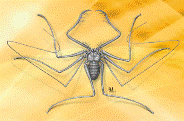Papers in the Biological Sciences

Eileen Hebets Publications
Document Type
Article
Date of this Version
January 2000
Abstract
This study used both correlative and experimental video playback methods to test the hypothesis that the secondary sexual traits of male wolf spiders act to increase the efficacy of visual courtship displays. Direct observations of courtship of several lycosid genera and a review of the literature revealed a significant association between ornamentation and visual courtship displays. This suggests that the ornamentation may be playing the role of amplifier for a visual display. To test this hypothesis, male courtship behaviors of four Schizocosa species were experimentally manipulated using video-imaging techniques. Females of species with non-visually displaying, non-ornamented males (Schizocosa duplex and S. uetzi) did not increase in frequency of receptivity when tufts were added to conspecific males. In a species with a visual display and foreleg pigmentation (S. stridulans), the addition of foreleg tufts increased female receptivity. In a tufted species (S. crassipes), females tended to decrease their receptivity when male ornamentation was completely removed. In visually displaying species, ornamentation acts to increase female receptivity, supporting its role as an amplifier of a visual display.


Comments
Published in Behavioral Ecology and Sociobiology 47 (2000), pp. 280–286. Copyright © 2000 Springer-Verlag. Used by permission. http://www.springerlink.com/content/0340-5443